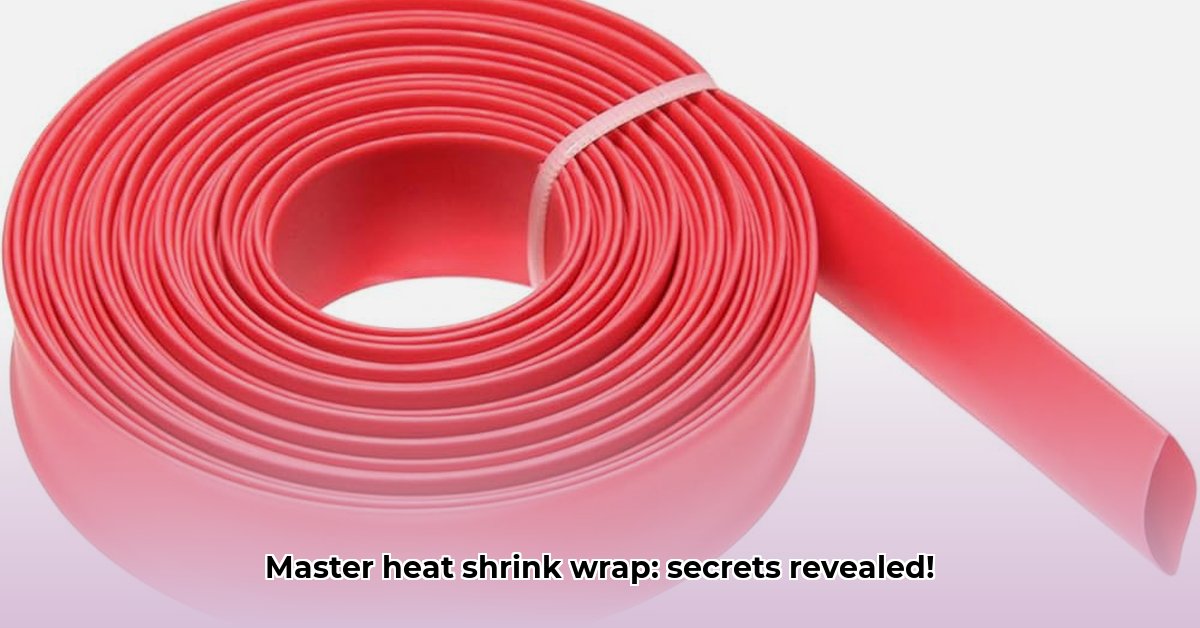Ever wondered about that clingy plastic wrap that shrinks tight when you heat it up? That’s heat shrink wrap, and it’s used for way more than just keeping your leftovers fresh! This comprehensive article breaks down everything you need to know about heat shrink wrap, from materials and applications to cost-effectiveness and environmental impact. Whether you’re a packaging expert or just starting out, this guide will help you select the perfect shrink wrap for your needs. For eco-friendly alternatives, consider sustainable heat options.
Heat Shrink Wrap: Your Ultimate Guide to Materials, Selection, and Applications
So, you’re curious about heat shrink wrap? It’s that amazing material that snuggles tightly around products, protecting them from bumps, scrapes, and the elements. With so many types and uses, choosing the right one can feel overwhelming. This guide simplifies the selection process, making it straightforward and efficient.
Understanding Heat Shrink Wrap Materials: More Than Meets the Eye
Heat shrink wrap isn’t a one-size-fits-all solution; consider it like choosing the right tool for a specific job. The most common materials are polyvinyl chloride (PVC) and polyolefin, but other options exist. PVC is known for its crystal-clear appearance and excellent shrink rate – consider it cling film on steroids! It’s cost-effective, making it a popular choice. However, it’s not the most eco-friendly option, and proper ventilation is required when using it with heat.
Polyolefin, on the other hand, is tougher, more flexible, and generally more environmentally sound. It’s a more durable choice, perfect for situations where you need extra protection, making it suitable for more demanding applications, including food packaging. It offers better clarity than some PVC options and doesn’t emit harmful odors when heated. However, it typically comes with a slightly higher price tag. Choosing between them really depends on your priorities and the specific requirements of your application.
Beyond PVC and Polyolefin, Polyethylene (PE) is often used for thicker, heavy-duty applications like pallet wrapping, offering excellent tear resistance. Consider the specific needs of your product and environment when selecting. Need pristine visibility? Food-safe material? Superior strength? A lighter environmental footprint? Then polyolefin is likely the winner.
New materials are emerging as well, including biodegradable and compostable options. The field is constantly evolving with new, more sustainable options hitting the market. This constant innovation could improve the durability of heat shrink wrap materials. The type of material you use will ultimately affects the shelf life of heat shrink wraps.
Heat Shrink Wrap Applications: A Universe of Possibilities
The uses for heat shrink wrap are as varied as the products it protects. Imagine it as a versatile superhero cape for your goods! It’s commonly used to safeguard items during shipping and handling. Think of all those fragile electronics or delicate components shipped across the country – heat shrink wrap acts as their guardian angel, protecting them from moisture, dust, and abrasion. It’s also perfect for bundling items for retail display, keeping those products neat and tidy on store shelves, and preventing tampering. Beyond retail, it finds a home in protecting wires and cables, creating a neat, professional look while also adding an extra layer of protection from damage or the elements. For example, heat shrink tubing is commonly used to insulate and protect electrical connections. It even helps secure food items, especially when you need a waterproof seal to preserve their freshness, for everything from frozen pizzas to candies.
Beyond these common uses, consider these specialized applications:
- Marine Industry: Protecting boats and equipment from harsh weather conditions.
- Construction: Encapsulating structures for weatherproofing or containment.
- Aerospace: Protecting sensitive components during manufacturing and transport.
The possibilities are really only limited by your imagination! However, before you choose, think carefully about where your product will end up. Will it be indoors, outdoors, exposed to rain or sun, or subjected to extreme temperatures? This will influence your material and thickness choices. A thin wrap might be perfect for indoor use, but a thicker, UV-resistant version might be necessary for outdoor exposure. Using a thicker wrap improves the overall protection of heat shrink wraps. Consider also the shape and size of the item you’re wrapping, as this will dictate the type of shrink wrap needed (e.g., bags, tubing, rolls).
Cost-Effectiveness: Balancing Initial Investment and Long-Term Savings
The initial cost of heat shrink wrap might seem inexpensive, but several factors contribute to its overall value. The type of material, how much you need, and the application method all affect the final price. Buying in bulk generally leads to lower costs per unit – it’s like buying in bulk at the grocery store; you get a lower price per item. PVC is generally less expensive than polyolefin, but consider the trade-offs in terms of durability and environmental impact.
Beyond the material costs, you need to factor in the time and equipment needed for the application. Manual heat guns are relatively inexpensive, but for high-volume applications, automated shrink wrapping machines can significantly increase efficiency. Some methods are faster and simpler than others. However, remember that while there’s an upfront investment, heat shrink wrap’s protective capabilities can ultimately save you money by reducing damage, spoilage, and losses. Proper application also minimizes waste and rework. The key is finding that sweet spot between the initial expenditure and the long-term savings it provides. Is there a cheaper alternative that offers the same level of protection? Consider things like stretch film and banding, but weigh their pros and cons carefully. It’s also important to factor in storage costs for heat shrink wrap materials; proper storage is essential to prevent damage and maintain quality.
Environmental Impact: Making Sustainable Choices
The environmental effect of heat shrink wrap is a growing concern. PVC, while a popular choice, isn’t biodegradable and can release harmful chemicals when incinerated. This means it lingers in landfills for a long time. Polyolefin fares better, yet it’s still not a perfect solution, as it’s typically not biodegradable either. The good news is that manufacturers are developing more eco-friendly alternatives! Biodegradable and recyclable options are appearing on the market, representing a significant step toward sustainability.
These alternatives often utilize plant-based materials or are designed to break down more readily in composting environments. However, biodegradable options may have limitations in terms of strength or clarity.
By opting for these greener choices, you not only reduce your environmental footprint, but you’re also supporting companies committed to sustainable practices. Every small choice counts! Manufacturers are focusing on developing recyclable heat shrink wraps to combat the environmental impact. You can also minimize waste by using the correct amount of wrap for each application and exploring options for recycling used shrink wrap. Partnering with a recycling center or participating in a take-back program can further reduce your environmental impact.
Selecting the Right Heat Shrink Wrap: A Simple, Step-by-Step Guide
Choosing the perfect heat shrink wrap is easier than you think. Follow these simple steps to find your ideal fit:
- Define your needs: What needs protection? What are you packaging? What will be the environment? How much protection is needed? What regulatory requirements must be met (e.g., food safety)? Write it all down!
- Choose your material wisely: PVC, polyolefin, polyethylene, or a sustainable alternative? Prioritize visibility, strength, flexibility, temperature resistance, or environmental impact.
- Get the right size and thickness: Measure your product accurately. The wrap should be slightly larger than the item being wrapped. A too-thin wrap offers little protection. Too thick, and you’re wasting materials and possibly adding unnecessary expense. Consult with a supplier to determine the appropriate gauge for your application.
- Consider the shrink rate: How tightly do you want the wrap to conform to your product? Some applications demand a tighter fit than others. Shrink rate is typically expressed as a percentage.
- Find a reliable supplier: Research suppliers and choose one with a reputation for good quality, competitive pricing, and excellent customer service – read reviews! Ask about their technical support and return policies.
Heat Shrink Wrap: Weighing the Pros and Cons
| Feature | Pros | Cons |
|---|---|---|
| Material | PVC: Crystal clear, excellent shrink rate, cost-effective; Polyolefin: Durable, more environmentally friendly, food-safe; Polyethylene: High tear resistance, good for heavy items. | PVC: Not biodegradable, emits odors, requires ventilation; Polyolefin: Can be more expensive; Polyethylene: Less clarity. |
| Application | Versatile, many uses, easy to apply (depending on the method and equipment); provides tamper evidence. | Needs specialized equipment for some applications; can be time-consuming. |
| Cost | Cost-effective in bulk; can save money by reducing damage; reduces spoilage | Initial investment in equipment may be required; material costs vary. |
| Environmental | Sustainable options available; reduces waste in some cases | Traditional materials not biodegradable; contributes to landfill waste. |
This guide provides a solid foundation for understanding heat shrink wrap. However, research is constantly evolving new materials and applications, so stay informed about the latest developments by consulting with suppliers and industry experts. Regularly check trade publications and online resources for updates. Remember to always prioritize safety when working with heat and tools. Wear appropriate safety gear, such as gloves and eye protection. Work in a well-ventilated area. With constant developments, how does one stay ahead of the latest heat shrink wrap materials? Subscribe to industry newsletters, attend trade shows, and
- Achieve Anesthesiology Work-Life Balance: Your Guide - December 4, 2025
- Unlock Young Doctors’ Work-Life Balance: Actionable Strategies Now - December 2, 2025
- Unlock Life Harmony: Work-Life Integration Guide - November 30, 2025
















